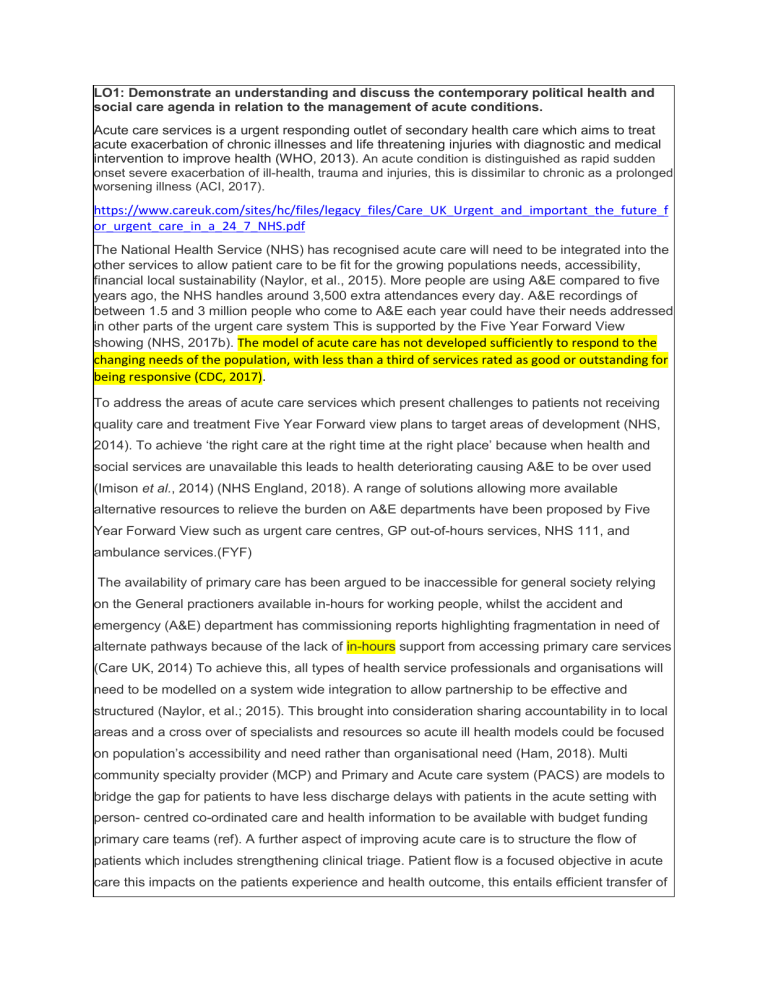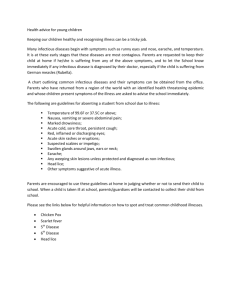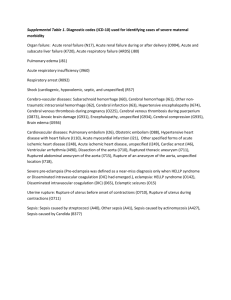
LO1: Demonstrate an understanding and discuss the contemporary political health and social care agenda in relation to the management of acute conditions. Acute care services is a urgent responding outlet of secondary health care which aims to treat acute exacerbation of chronic illnesses and life threatening injuries with diagnostic and medical intervention to improve health (WHO, 2013). An acute condition is distinguished as rapid sudden onset severe exacerbation of ill-health, trauma and injuries, this is dissimilar to chronic as a prolonged worsening illness (ACI, 2017). https://www.careuk.com/sites/hc/files/legacy_files/Care_UK_Urgent_and_important_the_future_f or_urgent_care_in_a_24_7_NHS.pdf The National Health Service (NHS) has recognised acute care will need to be integrated into the other services to allow patient care to be fit for the growing populations needs, accessibility, financial local sustainability (Naylor, et al., 2015). More people are using A&E compared to five years ago, the NHS handles around 3,500 extra attendances every day. A&E recordings of between 1.5 and 3 million people who come to A&E each year could have their needs addressed in other parts of the urgent care system This is supported by the Five Year Forward View showing (NHS, 2017b). The model of acute care has not developed sufficiently to respond to the changing needs of the population, with less than a third of services rated as good or outstanding for being responsive (CDC, 2017). To address the areas of acute care services which present challenges to patients not receiving quality care and treatment Five Year Forward view plans to target areas of development (NHS, 2014). To achieve ‘the right care at the right time at the right place’ because when health and social services are unavailable this leads to health deteriorating causing A&E to be over used (Imison et al., 2014) (NHS England, 2018). A range of solutions allowing more available alternative resources to relieve the burden on A&E departments have been proposed by Five Year Forward View such as urgent care centres, GP out-of-hours services, NHS 111, and ambulance services.(FYF) The availability of primary care has been argued to be inaccessible for general society relying on the General practioners available in-hours for working people, whilst the accident and emergency (A&E) department has commissioning reports highlighting fragmentation in need of alternate pathways because of the lack of in-hours support from accessing primary care services (Care UK, 2014) To achieve this, all types of health service professionals and organisations will need to be modelled on a system wide integration to allow partnership to be effective and structured (Naylor, et al.; 2015). This brought into consideration sharing accountability in to local areas and a cross over of specialists and resources so acute ill health models could be focused on population’s accessibility and need rather than organisational need (Ham, 2018). Multi community specialty provider (MCP) and Primary and Acute care system (PACS) are models to bridge the gap for patients to have less discharge delays with patients in the acute setting with person- centred co-ordinated care and health information to be available with budget funding primary care teams (ref). A further aspect of improving acute care is to structure the flow of patients which includes strengthening clinical triage. Patient flow is a focused objective in acute care this impacts on the patients experience and health outcome, this entails efficient transfer of patient care throughout health and social services which involves sharing intervention and assessment information (NHS, 2017a). For example, mental health care accounts for almost a quarter of all NHS activity, however spending on NHS services is equivalent to only half of this. CCG’s have underinvested in mental health services relative to physical health services due to low prioritisation and the obscured way that spending on mental health conditions is leading to strain on acute services (NHS, 2016). Mental health triage team (raid?) Overall The Government’s revised mandate to NHS England for 2018-19 shows objectives of how integration will improve health and social outcomes with the Department of Health and Social Care and NHS Digital sharing data on reducing acute inappropriate usage to ensure optimum responsive care is available to improve each year (NHS England, 2018). The Acute Care Model (Iyer et al., 2011) Name lots acute conditions even mental How five forward view will help acute treatment Introduce NMC code LO2: Understand the pathophysiology and discuss the presentation of common acute physical and mental health conditions. The understanding of acute conditions there can be subdivided into minor and major illnesses, minor include respiratory tract infections, gout, infective diarrhoea and vomiting, lassitude (lethargy), heart palpitations, allergies and anxiousness. (Ref below) Major acute conditions are more serious needing urgent treatment such as strokes, hypovolaemic collapse, sepsis, although some presenting through an exacerbations of a chronic condition such as an asthma attack, hypoglycaemia and inflammatory bowel disease (Jones et al., 2010). The presentation of an acute condition is not always observable to looking at the patient, to confirm diagnosis and treatment investigations into carryout blood tests and vital signs will show biological abnormalities although using nursing assessment criteria confirms rationale and allows person centred care…(ref) Symptoms can present on different levels such as objective, subjective.. These decisions are made based on recognizing and understanding the importance of changes in physical or mental status of residents and the impact of these changes on residents' quality of life. (Ashcraft and Owen, 2014) (reword) Acute mental illness is characterised by significant and distressing symptoms of a mental illness requiring immediate treatment. This may be the person's first experience of mental illness, a repeat episode or the worsening of symptoms of an often continuing mental illness (reword) (Joseph’s Health Care London, 2019). Anxiety will be displayed as excessive worrying, Bipolar Disorder presents as manic behaviour and depressive mood swings, delusions can be experienced as false beliefs not grounded. An independent inquiry into acute mental health patient support was carried out evidencing a lack of humanity, depersonalised care, treating the illness or managing the crisis rather than supporting or healing the individual, and emphasising risk rather than needs, were all themes that arose. To some extent these reflect the way that priority may be given to the medical management of acute mental health needs, while the other things that can help are devalued.(reword)(Mind, 2011) Schizophrenia is associated with: double the risk of death from heart disease and three times the risk of death from respiratory disease. This is because people with mental health conditions are less likely to receive the physical healthcare they're entitled to. Mental health service users are statistically less likely to receive the routine checks (like blood pressure, weight and cholesterol) that might detect symptoms of these physical health conditions earlier. They are also not as likely to be offered help to give up smoking, reduce alcohol consumption and make positive adjustments to their diet (Mental Health Foundation, 2019)Reword. http://ojin.nursingworld.org/MainMenuCategories/ANAMarketplace/ANAPeriodicals/OJIN/TableofC ontents/Vol-20-2015/No3-Sept-2015/Continuity-of-Care-Transitional-Care-Model.html Sepsis is a serious condition resulting from the presence of harmful microorganisms in the blood or other tissues and the body’s response to their presence, potentially leading to the malfunctioning of various organs, shock, and death. Reword. There is more people developing sepsis, an estimated 123,000 cases each year in England, with approximately 37,000 deaths are related with the condition and 65,000 people suffering serious long term complications reword (NHS England) (Angus and Van der Poll, 2013). It is known as a ‘silent killer’ because it can be extremely difficult to identify for both professionals and the public alike, with symptoms often suggesting less serious illnesses such as influenza (NHS England, 2015). The roles of inflammation and coagulation in the pathophysiology of sepsis are described. Sepsis results when an infectious insult triggers a localized inflammatory reaction that then spills over to cause systemic symptoms of fever or hypothermia, tachycardia, tachypnoea, and either leukocytosis or leukopenia. These clinical symptoms are called the systemic inflammatory response syndrome. Severe sepsis is defined by dysfunction of one of the major organ systems or unexplained metabolic acidosis. (J.Jacobi, 2002) (reword and shortened) The acute care journey of a patient presenting with sepsis will be discussed to present justification of contemporary use of acute care provision. The case-study will be anonymous to protect confidentiality and named Gabe (ref). This will provide an insight into how a patient is transitioned through stages of health care in relevance to the policy and guidelines when following evidencebased practice. This ultimately relies on the practioner’s interpersonal and professional skills to carry out responsive, safe care (Chen et al., 2017). How they arrive- end of bed assessment/ look, listen and feel Physical symptoms Gabe 74yrs old arrives by ambulance after a collapse his presented symptoms were handed over to the emergency department. Firstly, the A-E assessment (Airway, Breathing, Circulation, Disability, Exposure) was carried out, this is a systematic pneumonic taught alongside resuscitation training to prioritise actions to support life and assess an acutely ill patient to recognise and assess, effective training uses the look, listen and feel techniques (Atkinson, 2013; Resuscitation Council, 2014). Gabe examined to have a patent airway (unobstructed), tachypnoea using external respiratory muscles, skin was pale and clammy on touch CRT or CRP <2 (unperfused over 2 seconds) The vital observations were measured at a heart rate of 125 (tachycardia); oxygen saturation 95%; respiration count 25; blood pressure 80/45 (hypotensive); blood sugar 2.1mmol (hypoglycaemia) and temperature of 35.3c (below 36) (Appendix 1). This was recorded using the National Early Warning Score (2012) (NEWS) which assigns a score of the severity of the six routine based physiological parameters scoring at 8 and is now returned to consciousness with no pain expressed when asked between a score of 0-3 mild, moderate or severe (Royal college of physicians, 2012) . The NEWS system guides escalation or de-escalation of intervention and observation which gave Gabe 15 minutes observational intervals?) Although a study found cultural behavioural were barriers leading to depending on being task driven, inhibiting the use of the nursing clinical judgment therefore further training is needed when following the escalation protocols (C.foley and M.dowling). Neuro observations are a component in the NEWS this is a neurological assessment ‘AVPU’ standing for ‘Alert, Verbal, Pain, Unresponsive’ are commenced using the glycomascale this policy stated( ) when the reason for a unknown unconscious collapse.. describe. His vital signs and symptoms have required investigation into a query of the symptoms can be treated this doesn’t mean the condition will resolve and following tests are carried out to diagnose the underlying infection. Sepsis is a serious medical condition. It is caused by an overwhelming immune response to infection. The body releases immune chemicals into the blood to combat the infection. Those chemicals trigger widespread inflammation, which leads to blood clots and leaky blood vessels. As a result, blood flow is impaired, and that deprives organs of nutrients and oxygen and leads to organ damage. (National Institute of General Medical Science, 2018). Sepsis can be directly related to many chronic conditions being developed in older people to acquire sepsis are elderly, healing wounds, low immunity, recent surgery and contributing chronic conditions (P.Nasa, D.June, 2012) Sepsis 6 LO3. Demonstrate an understanding of the physical, psychological and social aspects associated with acute conditions. Gabe was due a transfer onto a general ward and on arrival he was updated with his current condition and informed of his condition and treatment and was considered, NICE guidelines are integrated on a specific acute care pathway ensuring the patients well-being is trained to be advocated through continuity of care (NICE,2007). Gabe was given a sepsis brochure this explained that the vast social and psychological impacts of suffering from sepsis (Anna Coles, 2012). https://www.nice.org.uk/guidance/cg50/chapter/1-Guidance#transfer-of-patients-from-criticalcare-areas-to-general-wards Ph Use nursing model- for patient symptoms for holistic your focus should be on the holistic nursing assessment of the patient not their medical assessment. It is accepted that your work may refer to the medical diagnosis and/or interventions offered to the patient, but this should not be the focus of your discussion. Below is a non-exhaustive list of factors you may want to consider; - LO4: Be able to support people experiencing acute conditions and plan their care effectively as part of the multidisciplinary team by reflecting on the holistic management of an acute condition from practice. review the nurse’s role in promoting self-care for patients and families. The handing over of care and multi- disciplinary teams will improve the quality of caring intervention however communication in relevance to acute care is susceptible to missed diagnoses, medication errors Introduce the reason nursing care models are used- holistic and person centred planning What is the medical model ,give benefite? Although nursing modelallows.. - What assessment tools models where used - How was care planned, did it make use of any tools or metrics? - What published guidelines/recommendations relate to your chosen patient and how did these influence your case study - What government initiatives and/or legislation influenced the situation - How, where and by whom was care delivered - What provision was given to the family and friends of the patient Models of communication- sbar Kings Fund- Minor Acute illnesses/ Major The key to high-quality care of acute illness will be found in the balance seen between acceptable access, satisfactory consultation, accurate diagnosis, effective treatment, appropriate referral, safe outcome, and efficient use of resources. These seven domains led to the development of nine measures of quality of acute illness that were submitted to the Inquiry team separately, the key headings for which are described below: 1. Good access for patients with acute medical problems, in terms of availability of face-to-face and telephone contact. 2. Sufficient time and facilities within the consultation to address problems and make an accurate assessment or diagnosis 3. Accurate diagnosis/assessment with an emphasis on not missing serious illness 4. Adequate patient information about diagnosis and its implications 5. Symptom resolution – patients with acute problems are treated appropriately and their symptoms resolved 13 The King’s Fund 2010 GP Inquiry Paper 6. Appropriate prescribing. Patients should not be given unnecessary antibiotics, non steroidal anti-inflammatory drugs etc. 7. Resources are used in a cost-effective manner 8. Patient satisfaction. Patients should be satisfied with their treatment and feel more empowered to deal with their problems 9. Appropriate referral, without over-referral (wasting resources) and under-referral (missing important diagnoses) L05: Demonstrate achievement of designated competencies supporting achievement of NMC requirements. Work as part of a team to ensure the effective delivery of safe and effective nursing care and demonstrate achievement of the NMC competencies, identified essential skills cluster / progression points for year 2 to progress to year 3. 2 sentences Curriculum of acute care- essential skills cluster Relate to Nmc competencies- preserve safety, prioritise people, practice effectively NMC Essential Skills Cluster states by entry to the register • ‘Acts autonomously and appropriately when faced with sudden deterioration in people’s physical or psychological condition or emergency, abnormal vital signs, collapse, cardiac arrest, self-harm, extremely challenging behaviour, attempted suicide.’ • ‘Measures, documents and interprets vital signs and acts autonomously and appropriately on findings’ Within this essay you are required to present a case study and discussion of a patient suffering from an acute physical or mental illness. The patient can be of any age as long as they have presented with an acute physical or mental illness. You must give the reader a brief but informative overview of the patient, their condition and presenting state of physical/emotional wellbeing. From here you will need to describe how they had been assessed and how their care had been planned and delivered. Keep in mind that your focus should be on the holistic nursing assessment of the patient not their medical assessment. It is accepted that your work may refer to the medical diagnosis and/or interventions offered to the patient, but this should not be the focus of your discussion. Below is a non-exhaustive list of factors you may want to consider; - - What assessment tools models where used - How was care planned, did it make use of any tools or metrics? - What published guidelines/recommendations relate to your chosen patient and how did these influence your case study - What government initiatives and/or legislation influenced the situation - How, where and by whom was care delivered - What provision was given to the family and friends of the patient Screen Capture (20 Sep 2019) Appendix 1





